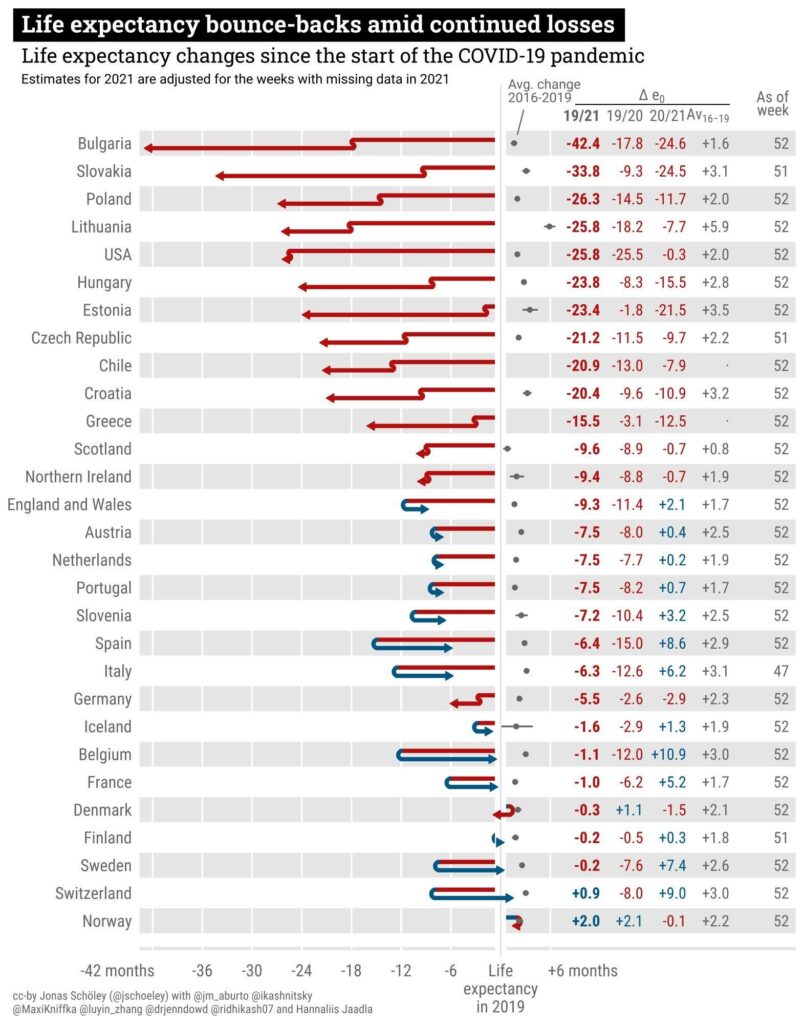Did life expectancy bounce back in 2021, or did things get even worse?
A: A mixed bag. While some countries saw improvements, life expectancy losses in the U.S. in 2021 were JUST AS BAD as 2020.
The Covid-19 pandemic has resulted in the largest loss of life expectancy seen in many countries since World War II. In 2020, U.S. males saw some of the worst losses—2.2 years of lost life expectancy in 2020.
Thanks to vaccines, COVID-19 death rates improved in many countries in 2021, despite the more transmissible Alpha, Delta, and Omicron variants.
BUT-countries with lower vaccine take-up, especially at older ages, still saw high mortality.
Life expectancy is one measure we use to summarize the mortality patterns of different countries over time. You’ve probably heard this statistic in the news your whole life—”life expectancy at birth for American males is 79 years,” for example. Life expectancy is calculated using deaths from ALL causes, so it doesn’t depend on the accuracy of recording COVID deaths.
❓But what does life expectancy mean? The number of years someone born today can expect to live….right?
Almost. Hold on for some nerdy demography 🤓:
💥Life expectancy is the number of years someone born today could expect to live… IF THEY WERE TO LIVE THROUGH THE AGE-SPECIFIC DEATH RATES OF *THIS* YEAR.💥
✅ Life expectancy is thus a snapshot of *current* mortality conditions.
❌ It’s not a forecast of the actual experience of newborns.
You read that right–life expectancy is calculated based on the pretend lives of an imaginary (or “synthetic”) group of people living through the risk of mortality at each age that exists today, without any improvements (or declines).
While this may seem counter to how life expectancy is commonly perceived, demographers nonetheless find this a very useful summary measure of population mortality.
❓WHY is life expectancy useful if it’s not actually how long I can expect to live?!
❓Why not JUST use excess mortality to summarize the COVID death toll?
Excellent questions!
Life expectancy has some advantages over excess mortality or raw mortality rates. The total number of deaths depends a lot on population size, as well how many young versus old people there are in a country. This makes it more difficult to compare across countries or over time.
In addition, we might care more about deaths at younger ages when someone has more remaining years to live. Life expectancy accounts for all these issues, allowing direct comparisons across countries of different sizes and age structures, and for the same country over time. Deaths that happen at younger ages contribute more to losses in life expectancy than deaths that happen at older ages. This is why countries that reduce infant and child mortality see rapid gains in life expectancy.
So, while life expectancy isn’t perfect, it IS super useful for comparing mortality across countries and time.
Nerdy Girl Jenn Dowd and her colleagues just published the first estimates of 2021 life expectancy for 29 countries with available data.
➡️ Key takeaways (see figure ):
14 of 29 countries saw life expectancy losses in BOTH 2021 & 2020 compared to 2019.
12 countries improved from 2020- but not back to 2019 levels.
2 countries (🇳🇴Norway & 🇨🇭Switzerland) beat pre-pandemic life expectancy.
1 country (🇩🇰 Denmark), saw a loss in 2021 but NOT 2020.

Bulgaria fared the worst, with a net life expectancy loss of 42.4 months since 2019, the most severe example of 9 countries from the former Eastern Bloc. With the exception of Slovenia, these countries all suffered compound life expectancy losses in 2021.
Belgium, 🇸🇪Sweden, 🇫🇷France, 🇮🇹Italy & 🇪🇸Spain witnessed bounce-backs from substantial life expectancy losses in 2020 with the first 3 getting back to the levels of 2019.
England & Wales showed a small bounce back, with a gain of 2.1 months in life expectancy in 2021 after a loss of 11.4 months in 2020.
Compared to 2019, life expectancy losses in the U.S. were JUST AS BAD in 2021 as 2020-a loss of over 25 months.
The U.S. was also an exception in that deaths UNDER age 60 contributed the most to life expectancy losses in 2021 compared to 2019.
Overall, the pandemic mortality burden shifted younger in 2021 compared to 2020. For example, in the US, mortality for 80+ returned to pre-pandemic levels. But overall life expectancy losses were WORSE in 2021 due to worsening mortality under age 60.
Even for countries that fared relatively well, COVID-19 still derailed the trajectory of mortality improvements. NO country achieved their projected life expectancy (based on pre-pandemic trends) without the pandemic.
❓Why has mortality in the U.S. been so much worse compared to Western European countries?
The reasons are complicated and will be the subject of much research. The U.S. has performed badly in life expectancy compared to Europe for the last two decades, with stagnation and even increases in mortality prior to COVID-19. While some of this poor performance was due to the opioid crisis, worsening health due to the obesity epidemic is also implicated.
The U.S. stood out in a bad way with large life expectancy losses in 2020 (more than 2 years), that were matched in 2021.
Some hypotheses for this U.S. “exceptionalism”:
➡️ Lower vaccination coverage, including boosters
➡️ Underlying vulnerability due to high prevalence of conditions such as diabetes
➡️ Less trust in government and corresponding compliance with public health guidance
BOTTOM LINE:
Life expectancy, despite the name, does not predict the future. It provides a useful snapshot of *current* mortality in a population.
This helps us quantify the losses due to COVID relative to other mortality “shocks” – in this case losses not seen since World War II. Even if these losses are transient (they won’t happen every year🤞), life expectancy helps us compare shocks across time and place.
By any measure, these losses are real and devastating. And as we often remind ourselves, these deaths are not just numbers. Each one represents a friend, a co-worker, a family member.
The outlook for 2022 is uncertain. Vaccines have muted the mortality impact of COVID in many countries, but others like the U.S. continue to see eye-wateringly high mortality. Better vaccine (+booster) coverage, higher levels of immunity from prior infection, and new treatments such as antivirals should lead to better outcomes in 2022, but new variants and a return to more relaxed behaviors could work in the opposite direction.
As always…stay tuned, stay safe and stay sane!
Love,
Those Nerdy Girls
Links:
Life Expectancy in 2021 pre-print
“U.S. Has Far Higher Covid Death Rate Than Other Wealthy Countries”
Context for longer term trends in U.S. stagnating life expectancy


